ORIGINAL
Effects
of multi-directional oscillatory vibration in the treatment of cellulite and
body remodeling
Efeitos da terapia
vibro-oscilatória multidirecional no tratamento da celulite e remodelamento
corporal
Fabiele Chieregato*,
Caroline Nogueira da Silva**, Tania Maria Carvalho***, Clovis Grecco**, Renata
Gomes Moreira**, Renata Michelini Guidi, PT****, Luis Fernando Girola**, José
Ricardo de Souza**, Débora Aparecida Oliveira Modena, PT, M.Sc.*****
*Esthetician,
Postgraduate in MBA Derma functional, Aesthetic and Cosmetic Center for Study
and Advanced Training Ibramed (CEFAI), Brazil, **Study Group in Applied
Technology to Health, IBRAMED, Amparo/SP, Brazil, ***MD, Gynecologist,
Universidade Estadual de Campinas (UNICAMP), Campinas/SP, Brazil, ****Master of
Electric Engineering of University of Campinas (Unicamp), Brazil, *****Student
in Electrical Engineering of University of Campinas (Unicamp), Study Group in
Applied Technology to Health, IBRAMED, Amparo/SP, *****Doctoral Student in
Science of Surgery of University of Campinas (UNICAMP), Study Group in Applied
Technology to Health, IBRAMED, Amparo/SP
Received:
March 19, 2019, accepted: January 27, 2020.
Corresponding
author: Débora Aparecida Oliveira
Modena, Av. Dr.
Carlos Burgos, 2800, 13901-080 Amparo SP
Fabiele Chieregato:
fabiele@ibramed.com.br
Caroline Nogueira da
Silva: c.silva@ibramed.com.br
Tania Maria Carvalho:
drataniamariacarvalho@gmail.com
Clovis
Grecco: clovis.grecco@alumni.usp.br
Renata Gomes Moreira:
r.moreira@ibramed.com
Renata
Michelini Guidi: renata@ibramed.com.br
Luis Fernando Girola: l.girola@ibramed.com.br
José Ricardo de Souza:
re_guidi@yahoo.com.br
Débora Aparecida
Oliveira Modena: de_modena@yahoo.com.br
Abstract
Introduction: Several technologies have been developed and optimized for the
treatment of unaesthetic disorders. Among them is the oscillatory vibration
therapy, a novel form of treatment based on the mechanical and physiological
fundamentals of the vibration platform. Objective: The present study
evaluated the efficacy of the oscillatory vibration therapy in the improvement
of body contour remodeling and in the aspect of cellulite in women. Methods:
This is a prospective longitudinal comparative study, in which the following
evaluation tools are used: anthropometry, perimetry, adipometry,
evaluation of skin viscoelasticity with Cutometer®, evaluation of the thickness
of the hypodermis with diagnostic ultrasound and analysis of severity of
cellulite (CSS). The evaluations occurred at the start and 1 week after the end
of ten oscillatory vibration therapy. The results were analyzing using a paired
student’s t-test with interval confidence of 95% (P-Value <0.05). Results:
Thirty women took part in the research, with age of 33 ± 9 years, weight of 62
± 11 kg, height of 1.66 ± 0.06 m, BMI of 22 ± 2 kg/m2. The
measurements of perimetry, adipometry, analysis of
subcutaneous tissue thickness by means of diagnostic ultrasound and analysis of
skin viscoelasticity did not present significant alterations. However, the CSS
variable of the right gluteus (7.3 ± 1.8 to 5.8 ± 1.6 ≤ 0.0001), left
gluteus (7.2 ± 1.9 to 5.8 ± 1.6= 0.0001), right thigh (6.9 ± 1.9 to 5.6 ± 1.4 =
0.0004), left thigh (6.9 ± 1.9 to 5.6 ± 1.3 = 0.0004) and Celluqol®
(59 ± 16 to 49 ± 16 = 0.022) presented significant difference. Conclusion:
The multi-directional oscillatory vibration therapy is an effective and
efficient therapy for the treatment of cellulite; however, for the treatment of
body remodeling, it must be further evaluated and studied.
Keywords: vibration platform, vibration, cellulite, body contour, aesthetic
medicine.
Resumo
Introdução: Várias tecnologias
vêm sendo desenvolvidas e otimizadas para o tratamento das afecções
inestéticas. Dentre elas está a terapia vibro-oscilatória, uma nova forma de
tratamento baseada na fundamentação mecânica e fisiológica da plataforma
vibratória. Objetivo: O presente estudo avaliou a eficácia da terapia
vibro-oscilatória para melhora do remodelamento corporal e aspecto de celulite
em mulheres. Métodos: Trata-se de um estudo clínico longitudinal prospectivo e
comparativo, no qual se utilizaram as seguintes ferramentas de avaliação:
antropometria, perímetria, adipometria,
avaliação da viscoelasticidade da pele com Cutometer®,
avaliação da espessura da hipoderme com ultrassom diagnóstico e análise da
escala de severidade da celulite (CSS). As avaliações ocorreram no início e
após 1 semana de término das dez sessões da terapia vibro-oscilatória. As
análises estatísticas foram realizadas com o software Bioestat
5.0, utilizando o teste de normalidade de Lilliefor
(P-Value > 0,05), teste paramétrico e teste T-Student da amostra pareada. Resultados: Trinta
mulheres participaram da pesquisa, com média de idade de 33 ± 9 anos, peso
médio de 62 ± 11 kg, altura média de 1,66 ± 0,06 metros, IMC médio de 22 ± 2
kg/m2. As medidas de perímetria, adipometria, análise da espessura do tecido subcutâneo por
meio de ultrassom diagnóstico e análise da viscoelasticidade da pele não
apresentaram alterações significativas. Entretanto as variáveis de CSS glúteo
direito (7,3 ± 1,8 para 5,8 ± 1,6 ≤ 0,0001), glúteo esquerdo (7, 2 ± 1,9
para 5,8 ± 1,6 = 0,0001), coxa direita (6,9 ± 1,9 para 5,6 ± 1,4 = 0,0004),
coxa esquerda (6.9 ± 1,9 para 5,6 ± 1,3 = 0,0004) e Celluqol®
(59 ± 16 para 49 ± 16 = 0,022), apresentaram diferença significativa. Conclusão:
A terapia vibro-oscilatória multidirecional é uma terapia efetiva e eficaz para
o tratamento da celulite, porém para o tratamento de remodelamento corporal ela
deve ser mais bem avaliada e estudada.
Palavras-chave: plataforma
vibratória, vibração, celulite, contorno corporal, medicina estética.
Introduction
The range of products with approaches for the treatment of unaesthetic
disorders is extremely wide: varying from non-invasive techniques, such as
cosmetic products, diets with or without nutritional supplements, manual
massages associated with electrotherapy resources to invasive forms, such as
liposuction [1,2].
The demand for this type of treatment and aesthetic surgery has been
increasing exponentially; year after year young individuals, men and women, set
out in search of their ideal body. To keep up with this growth, technology has
been advancing to fulfill the expectations of the population and innovating,
with new treatment methods in different fields of health and aesthetic medicine
[1,2].
Several technologies are being developed and optimized for the treatment
of aesthetic disorders. One of these technologies is the multi-directional
oscillatory vibration therapy, based on the mechanical and physiological
fundamentals of the vibration platform, or whole-body vibration (WBV). On the
platform, the vibration will run through the whole body, and thus stimulate
physiological events, such as the activation of blood flow, muscle activation
and rebalance; consequently, there is improvement in strength gains, resistance
and power in healthy individuals and even in individuals with some types of
musculoskeletal dysfunction [2-4].
Following this principle, multi-directional oscillatory vibration
therapy was developed to represent a low-cost mechanical massage technique,
whose objective is to assist the therapist during the aesthetic procedure,
potentializing the effect of the therapist’s hands, decreasing the treatment
time, and acting with safety and efficiency.
The equipment uses a mechanical system which consists of a disc-shaped
body, coupled to a motorized axis that moves in a multi-directional and
oscillatory manner, through an eccentric axis, executing back and forth
movements around a certain balanced position. The equipment engine is in the
applicator, and the multi-directional oscillatory vibration is transmitted to
the treatment area through a multipoint tip fixated onto the disc. (Figure 1)
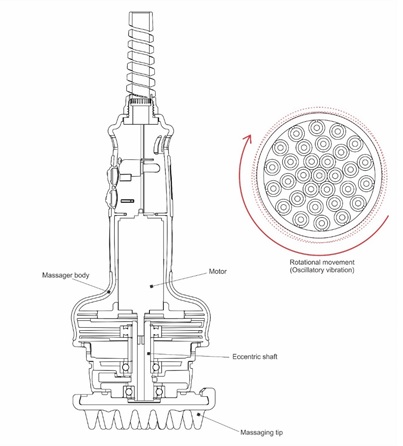
Source:
Author
Figure
1 - Internal mechanical system of the applicator.
The therapist must move the applicator continuously in a semi-circular
direction; therefore, the oscillatory vibration has effect on the treatment
area. It is necessary to adjust the frequency of cycles per second for each
therapeutic objective and always respect the acute response of the skin during
the treatment.
The objective of this study is to evaluate the efficacy of the
multi-directional oscillatory vibration treatment developed to act in the
fields of aesthetic medicine, aiming to improve body contour and the appearance
of cellulite.
Methods
This is a prospective longitudinal and comparative clinical study
approved by the local committee of ethics in research and registered in
Clinical Trials: NCT03312946. All the individuals were recruited at the (CEFAI)
- Ibramed Center for Advanced Studies and signed a
previous consent form.
The main eligibility criteria were: women between 18 and 55 years of
age; body mass index (BMI) of up to 29.9; non-smokers; without previous
conditions; with light, moderate and severe degrees of cellulite severity
according to the Cellulite Severity Scale (CSS) [5] in the gluteus and
posterior thigh areas and localized fat in the abdomen and flanks areas. The
main criteria of ineligibility were that the participants had received other
treatment for cellulite less than 30 days before the study, male gender,
suffering from dermatitis and dermatosis, fragility of the blood capillary,
history of deep venous thrombosis (DVT) neoplasia, having implanted cardiac
pacemakers or other implanted electronic devices.
Data collection was carried out by a specialized physiotherapist, with
the use of the following evaluation tools: anthropometry as weight (kg) and
height (m²) with the mechanical stadiometer (model 110 CH; Welmy,
SP, Brazil), and calculated using the BMI (kg/m²). For the body circumference
evaluation, a perimetry was carried out using a measuring tape (RCM®) around
the waist area, umbilical line, gluteus (the reference point being 5 cm lower
and lateral to the anatomical region of the greater trochanter of the femur)
and thighs: gluteus fold, medial fold (5 cm lower in relation to the gluteus
fold) and distal fold (15 cm lower in relation to the gluteus fold).
To evaluate the thickness of the skinfold an abdominal adipometry was carried out with the adipometer
(CESCORF®) in the infra-abdominal area (two fingers below the umbilical line in
the longitudinal direction) and supra-umbilical area, two fingers above the
umbilical line, transversal axis).
For the evaluation of cellulite, the Cellulite Severity Scale (CSS) was
used, which covers and classifies with punctuations from 0 to 3 the different
aspects of cellulite, such as: number of depressions, depth, morphological
aspect, degree of flaccidity, and the cellulite gradation according to Nürnberger & Müller. The sum of the punctuations of
each of these aspects generates the classification, which can be light (1 to
5), moderate (6 to 10) or severe (11-15) [5].
For the evaluation of skin elasticity, the Cutometer® MPA 580 (Courage-Khazaka, Germany) was used. The analysis of the thickness
of the subcutaneous tissue was performed by an ultrasonographer
physician, using the diagnostic ultrasound equipment with the frequency of 6-18
MHz (MyLab™ 25 Gold, Esaote,
Italy) with software VPan (Esaote,
Italy), in both evaluations, points marked by the evaluator in the abdomen,
flanks, gluteus and posterior of thighs were analyzed [6].
Before and after the treatment, the Celluqol®
questionnaire was applied, which evaluates how much cellulite affects the
quality of life and the lifestyle of women. The questionnaire is composed of
questions regarding the choice of clothes, diet, recreation and physical
activities, relationship with the partner, feelings and changes in daily
habits. Each question is ranked from 1, when the individual does not feel
disturbed by having cellulite, until 5, when the fact of having cellulite
disturbs the individual all the time. The result of Celluqol®
is the sum of all the points of each question. The final reevaluation of the
participants was carried out seven days after the end of the treatment [7].
Procedure
At the beginning of each session, a body exfoliation was performed in
the treatment area with physical exfoliant, and after that a cosmeceutical,
known as Creme Para Massagem Modellata
(Anvisa nº 25351.185215/2018-70) was applied to help
in the sliding of the equipment tip. The Modellata®
equipment (Ibramed-Indústria Brasileira
de Equipamentos Eletromédicos
EIRELI-Brazil) was used, in continuous mode, with frequency of 60 cycles per
second (cps), and the application was carried out in the abdomen area, flanks,
gluteus and posterior of thigh and the application technique followed was
suggested by the equipment manufacturer. The application time in each area was
based on the skin response of each patient; that is, at any sign of hyperemia
in the entire treatment area the therapy in the area was finalized. However,
when the patient did not present tissue hyperemia, the average treatment time
was fifty minutes. All the participants received 10 sessions, performed twice a
week.
Statistical
analysis
Statistical analyzes were performed with Bioestat
5.0 software (Sociedade Civil Mamirauá,
Amazonas, Brazil). The Lilliefors normality test (P > 0.05) was performed
and does not show deviation from normality. After assessing the normality of
data distribution, a parametric test was applied to detect significant
difference at 0.05 level. All data were expressed as mean ± standard deviation
and differences between mean values were compared with paired student’s t-test.
Results
Thirty women started and completed the treatment. They presented the
average ages of 33 ± 9 years, weight of 62 ± 11 kg, height of 1.66 ± 0.06 m,
and BMI of 22 ± 2 kg/m2. There was no alteration in weight and BMI
after the treatment.
The measurements of perimetry, adipometry,
analysis of thickness of subcutaneous tissue by diagnostic ultrasound and
analysis of viscoelasticity of skin by Cutometer® did not present significant
alterations (P < 0.05) as seen in tables I and II.
Table
I - Analysis of the measurements by perimetry, adipometry and diagnostic ultrasound.
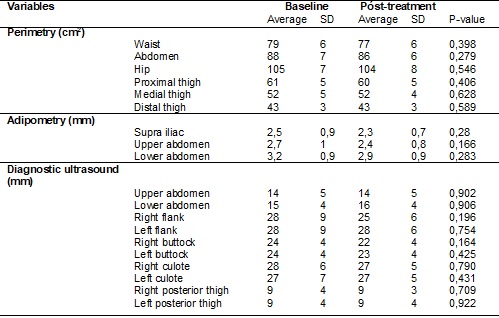
Table
II - Analysis of the measurements by Cutometer®.
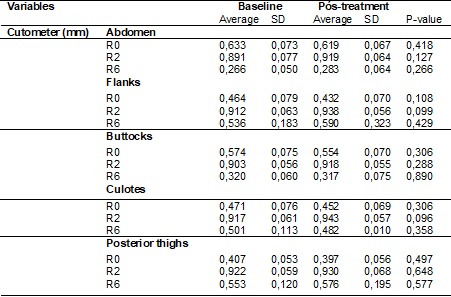
The CSS variables of right gluteus (7.3 ± 1.8 to 5.8 ± 1.6 ≤ 0.0001),
left gluteus (7.2 ± 1.9 to 5.8 ± 1.6= 0.0001), right thigh (6.9 ± 1.9 to 5.6 ±
1.4 = 0.0004), left thigh (6.9 ± 1.9 to 5.6 ± 1.3 = 0.0004) and Celuquol® (59 ± 16 para 49 ± 16 = 0.022) presented
significant differences as seen in the graphs below.
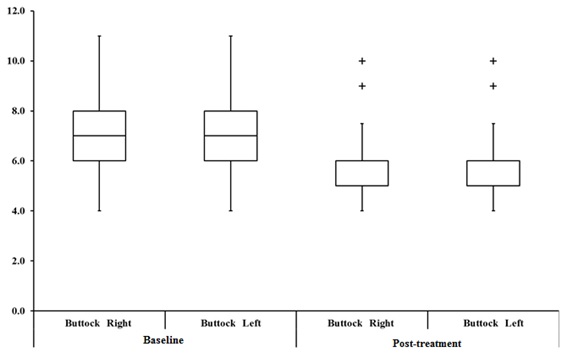
Graph
1 - CSS scale for gluteus.
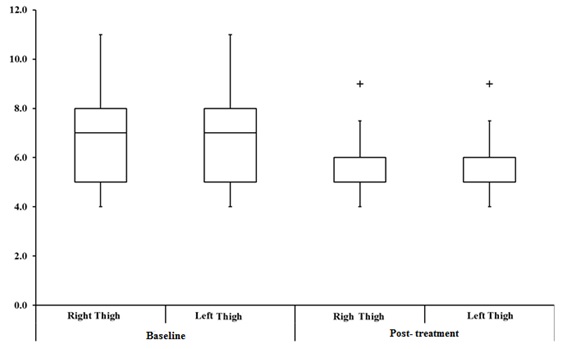
Graph
2 - CSS scale for posterior of thigh.
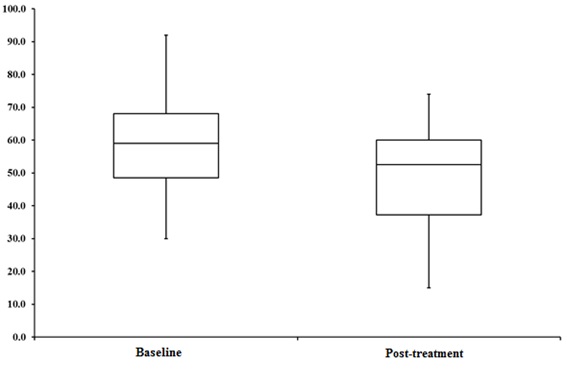
Graph
3 - Celluqol®
analysis.
Discussion
This is the first study to analyze the efficacy of multi-directional
oscillatory vibration by means of a piece of equipment developed exclusively
with that function. It is fair to say that the oscillatory vibration therapy is
a technological advancement of the conventional manual massage and of the
conventional vibration massage equipment currently present in the market, the
first treatment methods for some types of aesthetic disorders.
The practice of conventional massage dates back thousands of years, and
several studies have demonstrated its benefits and physiological effects are
renowned in the scientific field [8,9].
Currently, new techniques and several electromedical devices for the
treatment of aesthetic disorders such as localized fat and cellulite have been
used, for instance: ultrasound, focused ultrasound, radiofrequency,
carboxytherapy and, most recently, extracorporeal shockwave therapy [1,8,9].
The present study observes that the multi-directional oscillatory
vibration obtained significant results in the improvement of the appearance of
cellulite by the CSS scale analysis in gluteus and posterior of thighs,
corroborating the result presented by Celluqol®,
which showed significant difference in the improvement of quality of life and
lifestyle of the volunteers.
According to Turati et al. [10],
cellulite is defined as a metabolic disorder located in the subcutaneous
tissue, generating morphologic alterations on the skin surface. To guarantee
the efficacy of cellulite treatment, the stimulation of blood flow in a
homogeneous manner is necessary and vital to aid in the reactivation of local
metabolism [8-10].
Atamoros
et al. [12] report that manual or mechanical massage with the aid of
devices promotes lymphatic drainage and activation of microcirculation of the
subcutaneous tissue, therefore decreasing the lipedema associated with the
cellulite condition [11,12].
As cited previously, multi-directional oscillatory vibration therapy is
an enhancement of the technology of the vibration platform. Fuller et al. [13]
demonstrated that exercise with vibration can increase blood perfusion of the
skeletal muscle of the lower limbs. The correlation is that the increase of
blood flow is directly related to the frequency and load of vibration [13].
Savoia et al.
[14] evaluated the efficacy of the combination of Low-Level Laser Therapy
(LLLT) with the vibration platform. Thirty-three individuals took part in the
study, in which they received treatment interspersed, in the same session, with
vibration platform in different frequencies and LLLT (635 nm), in total the
therapy presented an average time of 23 to 28 minutes. The objective of the
study was to evaluate the application of the LLLT therapy combined with
vibration therapy for the reduction of circumference in patients with localized
fat and cellulite. The results suggested that the combination of therapies can
stimulate increase in metabolism and consumption of energy.
The combination of therapies was essential, because the therapy with the
vibration platform isolated is not able to induce lipolysis, provoking
exclusively basic processes involved in the pathogenetic of cellulite and
localized fat [14]. Furthermore, vibration is capable of stimulating the
enzymatic processes involved in the metabolism and stimulating the endothelial
functions and the muscles, due to the stimulation of the alpha motor neurons,
thus resulting in an increase of muscle activity, increase in O2
consumption and basal metabolic rate, which in a way potentialize the effects
of the LLLT therapy [13,14].
Through the scientific knowledge of the physiological effects stemming
from vibration, some devices have appeared, which use vibration therapy as a coadjuvant for other types of therapy, to potentialize the
results.
As Adatto et al. [15] the authors used
extracorporeal shockwave equipment which presented a handpiece with an
oscillatory vibration therapy system at 35 Hz (Cellactor®
SC1 (Storz Medical AG, Gerwilen, Switzerland) to
improve the aspect of cellulite and body remodeling as an indirect effect.
According to the authors, vibration is a tool, which can help in the result of
the treatment, for when in direct contact with the tissue, stimulates
metabolism, lymphatic flow, accelerates the elimination of residues and causes
a relaxing effect on muscles and tissues, which contributes to long-lasting
results, especially in body remodeling and cellulite.
Our results demonstrated a tendency of improvement of body modeling in
relation to the variables of perimetry, adipometry
and analysis of the thickness of subcutaneous tissue, as seen in table I, which
shows a subtle improvement of the variables.
Maloney-Hinds et al. [16] compared the effects of the frequencies
of 30 Hz and 50 Hz isolated and in the same session and observed that there was
increase in blood flow at 5 minutes of treatment in both frequencies [16,17].
According to Pastouret et al. [18]
vibration has its effects in blood circulation and indicates that the
mechanical massage on the skin, induced by vibration, presents a positive
effect in the superficial lymphatic system; a system which is essential in the
physiopathology of cellulite.
In theory, the oscillatory vibration therapy accelerates blood flow and
vasomotor activity, indirectly favoring lipolysis. The lymphatic vases in the
tissue increase their drainage, returning the substances that compose the
lymphatic to the venous system. Thus, it is known that the slow blood flow
causes lipogenesis, whereas fast blood flow stimulates lipolysis; that is, fat
degradation – an important factor for cellulite treatment [8,17,18].
As a hypothesis, it can be said that the present study demonstrated the
effect of multi-directional oscillatory vibration therapy and its possible role
in local blood flow with subsequent activation of metabolism, favoring the
improvement in the aspect of cellulite in the gluteus and posterior of thigh
areas.
Further studies must be carried out with multi-directional oscillatory
vibration therapy with new evaluation tools, for it is believed that the
therapy can cause non-lethal damage to the adipocytes and, with that, cause
them to suffer an improvement in their distribution in the tissue, which promotes
an improvement of body contour.
Conclusion
We conclude that oscillatory vibration therapy is effective and
efficient for the treatment of cellulite, for the main role of oscillatory
vibration therapy is the stimulation of local blood flow, and that is an
essential factor to obtain satisfactory results in the treatment of cellulite.
References
- Hexsel D, Siega
C, Souza SJ, Stapenhorst A, Rodrigues CT, Brum C.
Assessment of psychological, psychiatric, and behavioral aspects of patients
with cellulite: a pilot study. Surg Cosmet Dermatol
2012;4(2):131-6.
- Gonzalez
MCM, Gonzalez MAR, Tapia GA. Aesthetic dermatology and emotional well-being
questionnaire. M J Cosmet Dermatol 2014;13:336-45.
https://doi.org/10.1111/jocd.12109
- Games
EK, Sefton MJ, Wilson EA. Whole-body vibration and blood flow and muscle
oxygenation: a meta-analysis. J Athl Train
2015;50(5):542–54. https://doi.org/10.4085/1062-6050-50.2.09
- Rajek WM, Mieszkowski
J, Niespodziński B, Ciechanowska K. Whole-body vibration
exercise in postmenopausal osteoporosis. Prz Menopauzalny 2015;14(1):41-7.
- Hexsel D, Dal’Forno
T,Hexsel CL. A validated photonumeric cellulite severity scale. JEADV 2009;23:523-8.
https://doi.org/10.1111/j.1468-3083.2009.03101.x
- Woo
MS, Lua KJ, Jung HY, Parque SR, Lua TK, Kim NS, Lee BC. Comparison of skin
elasticity test results from the Ballistometer(®) and Cutometer(®). Skin Res Technol
2014;20(4):422-8. https://doi.org/10.1111/srt.12134
- Hexsel
D, Weber MB, Taborda ML, Dal'Forno T, Prado DZ. Celluqol® - a quality of life
measurement for patients with cellulite. Surg Cosmet
Dermatol 2011;3(2):96-101.
- Tunay VB, Akbayrak
T, Bakar Y, Kayihan H, Ergun N. Effects of mechanical
massage, manual lymphatic drainage and connective tissue manipulation
techniques on fat mass in women with cellulite. J Eur Acad Dermatol Venereol
2010;24(2):138-42. https://doi.org/10.1111/j.1468-3083.2009.03355.x
- Modena DAO, Silva CN, Grecco C, Guidi RM, Moreira RG,
Coelho AA et al. Extracorporeal shockwave: mechanisms
of action and physiological aspects for cellulite, body shaping, and localized
fat-Systematic review. J
Cosmet Laser Ther
2017;19(6):314-9. https://doi.org/10.1080/14764172.2017.1334928
- Turati F, Pelucchi
C, Marzatico F, Ferraroni
H, Decarli UM, Gallus S et
al. Efficacy of cosmetic products in cellulite reduction:
systematic review and meta-analysis. J Eur Acad
Dermatol Venereol 2014;28(1):1-15.
https://doi.org/10.1111/jdv.12193
- Alizadeh
Z, Halabchi F, Mazaheri R, Abolhasani M, Tabesh M. Review of
the mechanisms and effects of noninvasive body contouring devices on cellulite
and subcutaneous fat. Int J Endocrinol Metab
2016;14(4):e36727. https://doi.org/10.5812/ijem.36727
- Atamoros PMF, Perez AD, Sigall AD, Romay AAA, Gastelum BAJ, Salcedo PAJ et al. Evidence-based treatment
for gynoid lipodystrophy: A review of the recent literature. J Cosmet Dermatol 2018;17(6):977-83.
https://doi.org/10.1111/jocd.12555
- Fuller
TJ, Thomson LR, Peter RC, Buckley DJ. Effect of vibration on muscle perfusion:
a systematic review. Clin Physiol Funct
Imaging 2013;33:1-10.
https://doi.org/10.1111/j.1475-097X.2012.01161.x
- Savoia A, Landi
S, Vannini F, Baldi A.
Low-level laser therapy and vibration therapy for the treatment of localized
adiposity and fibrous cellulite. Dermatology and Therapy 2013;3(1):41-52.
https://doi.org/1007/s13555-013-0026-x
- Adatto MA1, Adatto-Neilson
R, Novak P, Krotz A, Haller G. Body shaping with
acoustic wave therapy AWT(®)/EPAT(®): randomized,
controlled study on 14 subjects. J Cosmet Laser Ther 2011;13(6):291-6.
https://doi.org/10.3109/14764172.2011.630089
- Maloney-Hinds
C, Petrofsky JS, Zimmerman L. The effect of 30 Hz vs.
50 Hz passive vibration and duration of vibration on skin blood flow in the
arm. Med Sci Monit 2008;14(3):112-6.
- Lohman
EB, Petrofsky JS, Maloney-Hinds C, Betts-Schwab H , Thorpe D. The effect of whole body
vibration on lower extremity skin blood flow in normal subjects. Med Sci
Monit 2007;13(2):71-6.
- Pastouret F, Cardozo L, Lamote J, Buyl R, Lievens P. Efeitos de vibrações multidirecionais entregues
em uma posição horizontal (andullation®) em
microcirculação sanguínea em animais de laboratório: um estudo preliminar. Med Sci Monit
Básico Res 2016;22:115-22.